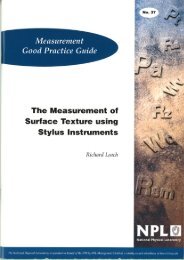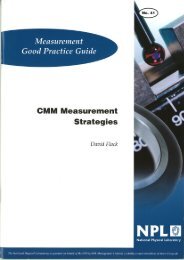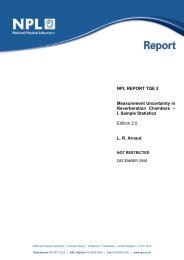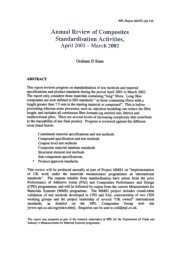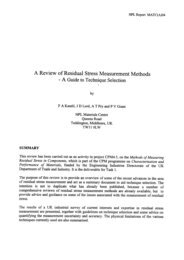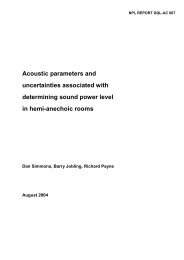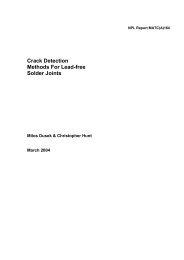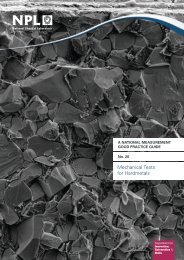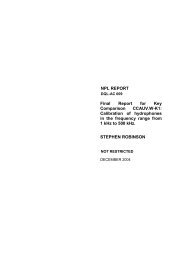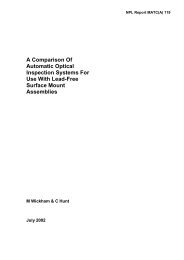Protocol for Establishing and Maintaining the Calibration - NPL ...
Protocol for Establishing and Maintaining the Calibration - NPL ...
Protocol for Establishing and Maintaining the Calibration - NPL ...
You also want an ePaper? Increase the reach of your titles
YUMPU automatically turns print PDFs into web optimized ePapers that Google loves.
30 Good Practice Guide 93 Chapter 2<br />
2.11 Specific Problem of Assaying Pure Beta Emitters<br />
Any list of radionuclides used clinically includes pure beta emitters, such as 90 Y, 32 P <strong>and</strong> 90 Sr. The<br />
conventional radionuclide calibrator, incorporating an ionisation chamber, is designed principally<br />
<strong>for</strong> <strong>the</strong> measurement of radioactivity when <strong>the</strong> spectrum of <strong>the</strong> radionuclide includes photon<br />
emissions. However, <strong>the</strong> sensitivity of such a device is low <strong>for</strong> beta radiations as most or all of <strong>the</strong><br />
beta particles are absorbed in or attenuated by <strong>the</strong> material of <strong>the</strong> source (e.g. <strong>the</strong> solution itself <strong>and</strong><br />
<strong>the</strong> container walls) <strong>and</strong> <strong>the</strong> walls of <strong>the</strong> ionisation chamber.<br />
The response from beta particles arises from bremsstrahlung radiation. As beta particles decelerate<br />
in an attenuating medium, a continuous spectrum of X-rays is produced. This bremsstrahlung<br />
(braking) radiation has intensity proportional to <strong>the</strong> square of <strong>the</strong> atomic number of <strong>the</strong> absorbing<br />
material <strong>and</strong> contributes to <strong>the</strong> current produced within <strong>the</strong> ionisation chamber. There<strong>for</strong>e, during<br />
assay of a radionuclide where <strong>the</strong> spectrum includes both beta <strong>and</strong> gamma radiations, most of <strong>the</strong><br />
current produced in <strong>the</strong> ionisation chamber is due to <strong>the</strong> interactions of <strong>the</strong> gamma photons with a<br />
much lower contribution from <strong>the</strong> beta particles. As an example, <strong>the</strong> current produced per MBq of<br />
131 I might be 30 times greater than that produced per MBq of 32 P.<br />
Pure beta emitting radionuclides are used generally <strong>for</strong> <strong>the</strong>rapeutic purposes <strong>and</strong> ‘it has been<br />
customary to dispense <strong>the</strong>rapeutic activities to within 5 per cent of that prescribed’ [25]. The source<br />
geometry <strong>and</strong> o<strong>the</strong>r factors affecting a measurement have been discussed in detail in this chapter.<br />
These factors are particularly important in <strong>the</strong> assay of pure beta emitters <strong>and</strong> particular attention<br />
must be paid to any corrections necessary due, <strong>for</strong> instance, to volume or container changes, in<br />
order to meet this more stringent accuracy requirement.<br />
At least one device is available, which uses a sodium iodide detector optimised <strong>for</strong> bremsstrahlung<br />
(Capintec Inc., Beta-C). The greater sensitivity of <strong>the</strong> sodium iodide detector results in a greater<br />
signal <strong>for</strong> <strong>the</strong> electrometer to measure. Improving <strong>the</strong> signal reduces <strong>the</strong> errors in <strong>the</strong> measurement.<br />
The accuracy of <strong>the</strong> Capintec instrument is stated to be ±5%, ‘relative to <strong>the</strong> st<strong>and</strong>ard sample used<br />
to calibrate <strong>the</strong> system’. The greater accuracy in a reading does not exclude <strong>the</strong> necessity <strong>for</strong><br />
scrupulous attention to <strong>the</strong> geometry <strong>and</strong> o<strong>the</strong>r corrections <strong>and</strong> <strong>the</strong> system must be calibrated <strong>for</strong> <strong>the</strong><br />
containers <strong>and</strong> volumes to be used clinically.



